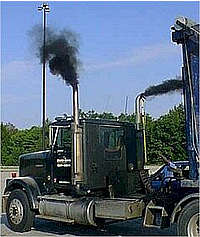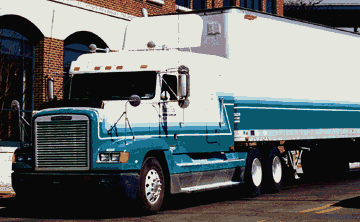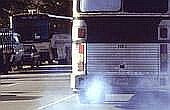|
EPA has regulated highway diesel fuel quality since 1993. As part
of the Clean Diesel Trucks and Buses program, EPA reduced the level
of sulfur in highway diesel fuel by 97 percent starting in 2006.
Likewise, the Clean Air Nonroad Diesel Rule includes new fuel requirements
that will decrease the allowable levels of sulfur in fuel used in
nonroad diesel engines, locomotives, and marine vessels by 99 percent.
Lowering sulfur in diesel fuel makes it possible for engine manufacturers
to use advanced clean technologies which can be damaged by sulfur,
just as lead was phased out of gasoline to prevent damage to catalytic
converters. In addition, reducing sulfur levels will provide immediate
public health benefits by reducing particulate matter from engines
in the existing fleets of highway trucks and buses, nonroad equipment,
locomotives, and marine diesel engines.
 Clean
Diesel Fuel Implementation Workshop being held November 15-16, 2004
in New Orleans, Louisiana Clean
Diesel Fuel Implementation Workshop being held November 15-16, 2004
in New Orleans, Louisiana
Co-sponsored by the U.S. Environmental Protection Agency (US EPA),
the American Petroleum Institute (API), the Association of American
Railroads (AAR), the American Trucking Association (ATA), the Association
of Oil Pipelines (AOPL), the Independent Fuel Terminal Operators
Association (IFTOA), the Independent Liquid Terminals Association
(ILTA), the National Association of Convenience Stores (NACS), the
National Association of Truck Stop Operators (NATSO), the National
Petrochemical and Refiners Association (NPRA), the National Tank
Truck Carriers (NTTC), the Petroleum Marketers Association of America
(PMAA), and the Society of Independent Gasoline Marketers of America
(SIGMA).
The workshop is geared to refiners, pipeline operators, terminal
operators, marketers and end-users of diesel fuel who may be subject
to, or affected by, the low and ultra-low sulfur requirements for
nonroad and highway diesel fuels. The workshop will include sessions/panels
on the following items:
- Overview of the Highway and Nonroad Diesel Rules
- EPA Presentation of the 2nd Annual Highway Diesel Pre-compliance
Reports
- Sampling and Sulfur Testing
- Refiners Progress Toward Implementation
- Pipelines Progress Toward Implementation
- Terminal Operators Progress Toward Implementation
- Rack-to-Consumers Progress Toward Implementation
For additional information, and to register for the workshop, please
visit:
http://api-ep.api.org/printerformat.cfm?ContentID=E2D33972-A89B-46AC-85CCF7F99212B4DB

Program Descriptions
 Clean
Air Nonroad Diesel Engines and Fuel Clean
Air Nonroad Diesel Engines and Fuel
In May 2004, EPA adopted a comprehensive national program
to reduce emissions from future nonroad diesel engines by integrating
engine and fuel controls as a system to gain the greatest emission
reductions. Exhaust emissions from these engines will decrease by
more than 90 percent. Because the emission-control devices can be
damaged by sulfur, the final rule also reduces the allowable level
of sulfur in nonroad diesel fuel by more than 99 percent, which
will result in immediate improvements in public health by reducing
particulate matter from engines in the existing fleet of nonroad
equipment. These emission reductions in nitrogen oxides and particulate
matter will provide enormous public health benefits, including preventing
12,000 premature deaths, 8,900 hospitalizations, and one million
work days lost by 2030. The Rule is one of a suite of inter-related
rules known as the Clean
Air Rules of 2004 which address ozone and fine particle pollution,
nonroad diesel emissions, and power plant emissions of sulfur dioxide,
nitrogen oxides and mercury.

Locomotives
In May 2004, EPA announced its intent to propose more stringent
locomotive engine emission standards that are modeled after the
Clean Air Nonroad Diesel engines programs. Such standards would
require the use of advanced emission-control technologies similar
to those already upcoming for heavy-duty
diesel trucks and buses. The availability of clean nonroad diesel
fuel required under the new nonroad fuel standards will enable the
use of the use of this technology on locomotive engines. EPA estimates
that nitrogen oxides and particulate matter emissions could be reduced
by 90 percent by applying such advanced technology to locomotive
engines.

Diesel Boats &
Ships
In May 2004, EPA announced its intent to propose more stringent
emission standards for new marine diesel engines with per cylinder
displacement below 30 liters and to engines at or below 37kW. These
standards, which are modeled after the Clean
Air Nonroad Diesel engines program, would require the use of
advanced emission-control technologies similar to those already
upcoming for heavy-duty
diesel trucks and buses. The availability of clean nonroad diesel
fuel required under the new nonroad fuel standards will enable the
use of this technology on marine diesel engines. EPA estimates that
NOx and PM emissions could be reduced by 90 percent by applying
such advanced technology to these marine diesel engines.
 Clean Diesel Trucks and Buses
Clean Diesel Trucks and Buses
Proposed
Rule (signed June 3, 2004) - In-Use Testing for Heavy-Duty Engines
and Vehicles
EPA is proposing a manufacturer-run, in-use emissions testing program
for heavy-duty diesel trucks. Under this ground-breaking program,
engine manufacturers will measure emissions from their diesel engines
in highway applications using portable onboard emission measurement
systems. This proposal advances EPA's clean diesel activities
by helping to ensure that the benefits of more stringent emission
standards are realized under real-world driving conditions.
In 2000, EPA finalized
a major regulation that reduces the sulfur content in diesel fuel
by 97 percent, providing for the cleanest-running heavy-duty trucks
and buses in history. By addressing diesel fuel and engines
together as a single system, harmful emissions from diesel and gasoline
heavy trucks and buses will be reduced up to 95 percent. Diesel
engine manufacturers will have flexibility to meet the new standards
through a phase-in approach between 2007 and 2010.
 Clean School Bus USA Clean School Bus USA
EPA's Clean School Bus USA program brings together partners from
business, education, transportation, and public health organizations
to work toward eliminating unnecessary public school bus idling;
retrofitting buses with better emission control technologies; and
replacing the oldest buses in the fleet with new, less polluting
buses.
 SmartWay
Transport
SmartWay
Transport
EPA created SmartWay Transport, a partnership with leading freight-haulers,
retailers and manufacturers,to reduce fuel consumption from the
transportation sector in the United States; emissions affecting
human health, especially in densely populated urban areas; and greenhouse
gas emissions.
 Voluntary Diesel
Retrofit Program
Voluntary Diesel
Retrofit Program
This program addresses pollution from diesel construction equipment
and heavy-duty vehicles that are currently on the road today.
The Program is building a market for clean diesel engines by working
with state, localand industry partners to create demonstration projects
around the country.
 Diesel
Fuel Programs
Diesel
Fuel Programs
EPA has regulated highway diesel fuel quality since 1993. As part
of the Clean Diesel Trucks and Buses program, EPA reduced the level
of sulfur in highway diesel fuel by 97 percent starting in 2006.
Likewise, the Clean Air Nonroad Diesel Rule includes new fuel requirements
that will decrease the allowable levels of sulfur in fuel used in
nonroad diesel engines, locomotives, and marine vessels by 99 percent.
Lowering sulfur in diesel fuel makes it possible for engine manufacturers
to use advanced clean technologies which can be damaged by sulfur,
just as lead was phased out of gasoline to prevent damage to catalytic
converters. In addition, reducing sulfur levels will provide immediate
public health benefits by reducing particulate matter from engines
in the existing fleets of highway trucks and buses, nonroad diesel
equipment, locomotives, and marine diesel engines.
 Health
Assessment Document for Diesel Exhaust
Health
Assessment Document for Diesel Exhaust
This May 2002 major report examines possible health hazards associated
with exposure to diesel engine exhaust.
Fact Sheets
About PDF Files
For further information or assistance regarding this web page,
please contact the Assessment and Standards Division Information
Line at (734) 214-4636 or email: asdinfo@epa.gov.
|

